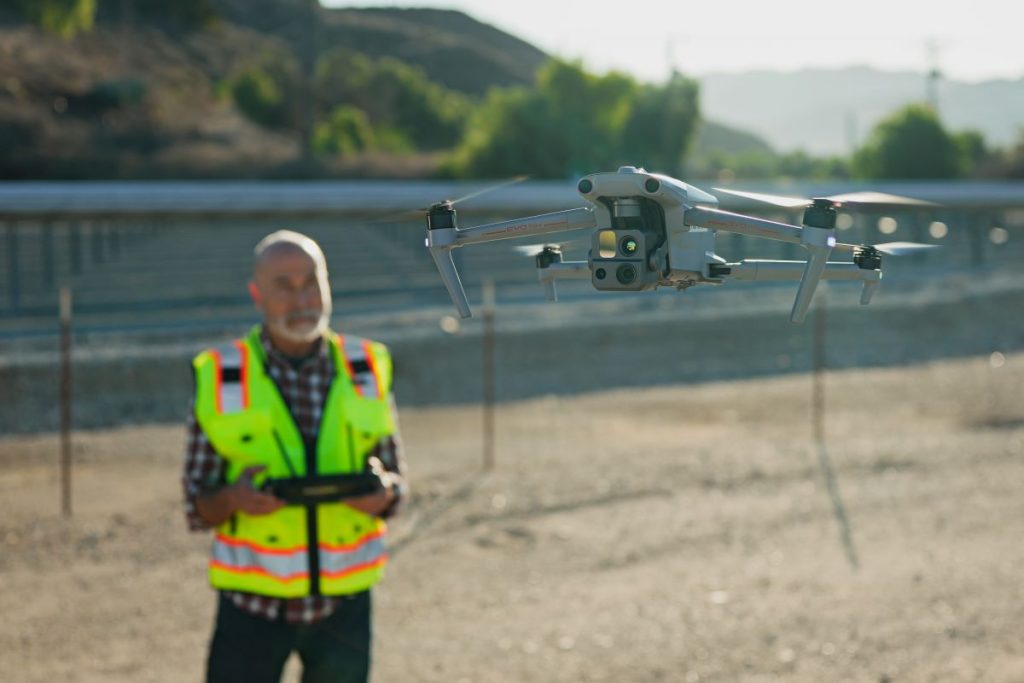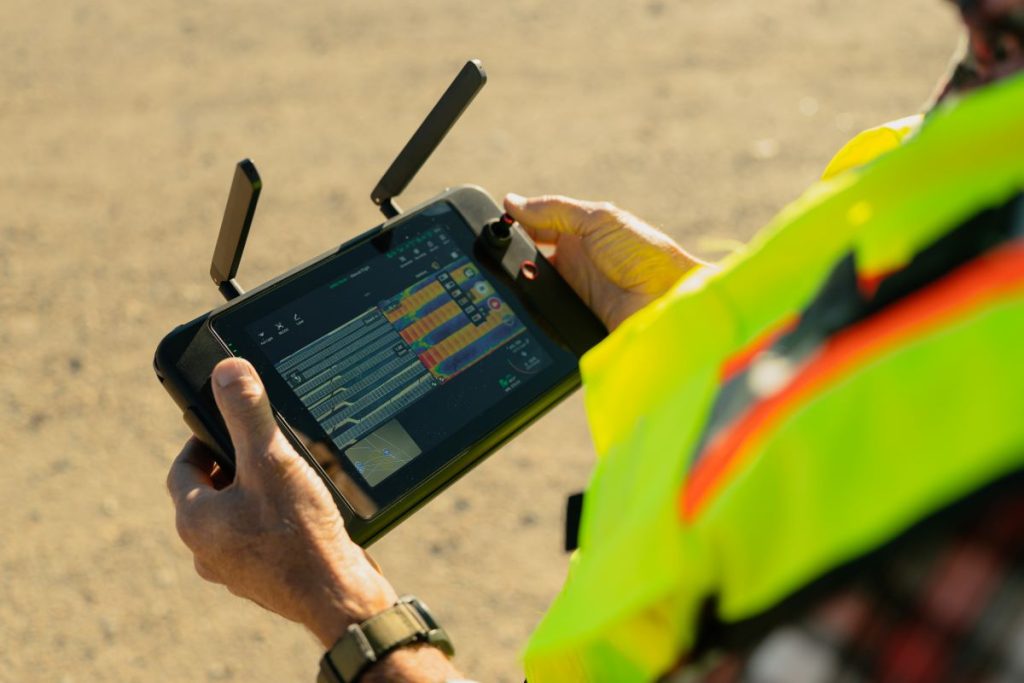As a leader in security, defense, and public safety solutions, Covered 6 recognizes the critical role that precision and efficiency play across all industries—including solar energy. Utilizing drones for critical infrastructure protection as well as solar panel inspection is transforming how inspections are conducted, delivering faster, more accurate results while reducing operational risks. Drone solar inspections are focusing on improving efficiency, cost savings, and accuracy.
Drones significantly improve the efficiency and accuracy of solar panel inspections by enabling rapid thermal assessments and comprehensive system coverage, providing a high level of detail that surpasses manual inspection methods. The integration of advanced imaging technologies, machine learning, and AI within drone platforms enhances fault detection and streamlines maintenance workflows. Partnering with specialized drone providers, including Covered 6 and our trusted collaborators, equips solar operations with cutting-edge technology, tailored solutions, and professional training—maximizing operational efficiency and reducing costs.
The Role of Drones in Solar Panel Inspections
At Covered 6, we understand that operational safety and precision are paramount. Drones equipped with high-resolution visual and thermal sensors offer a safer, faster, and more reliable alternative to manual solar panel inspections. Unlike traditional ground-based inspection techniques, which require technicians to walk the site on foot to inspect panels—an approach that is both time-consuming and potentially hazardous—drones eliminate the need for foot-based inspections. Ground-based methods are limited by slower coverage, increased risk to personnel, and the potential for missed issues, whereas drones provide thorough coverage of solar installations, significantly decreasing inspection time and minimizing personnel exposure to hazards.
By deploying drones, utility-scale solar farms benefit from enhanced inspection efficiency and accuracy. This approach ensures no panel is overlooked, while overcoming the limitations of ground-based inspections and reducing risks associated with traditional inspection methods.

Enhanced Inspection Efficiency
Drones revolutionize inspection efficiency through several key advantages:
- Performing thermal inspections at a rate of approximately 10 minutes per megawatt—a substantial improvement over manual methods.
- Collaborating with specialized drone operators, including Covered 6, further accelerates issue identification and data collection.
- Rapid assessment of extensive solar installations translates into improved operational efficiency, conserving time and resources.
Drone inspection platforms also facilitate collaboration among subcontractors and on-site technicians, streamlining teamwork to improve defect management and maintenance workflows.
Improved Data Accuracy
Data integrity is critical in solar panel inspections. Drones equipped with advanced imaging technology deliver high-resolution visual data capable of detecting minor defects. Thermal imaging reveals subtle temperature anomalies indicative of underlying issues such as module delamination or electrical equipment faults. Drone technology also enables precise evaluation of individual modules for performance testing, failure detection, and warranty claims.
Real-time analytics and detailed post-inspection reporting enable swift and accurate problem diagnosis. Covered 6’s expertise in integrating such technologies ensures reliable, actionable data that surpasses traditional inspection accuracy.


Key Features of Effective Drone Technology for Solar Inspections
Effective drone platforms designed for solar inspections incorporate critical features that optimize inspection workflows. High-resolution cameras and thermal imaging systems capture detailed visual and thermal data. The integration of machine learning and AI enhances fault detection accuracy and facilitates predictive maintenance.
Robust design elements, including durability and max wind resistance, ensure reliable operation under diverse environmental conditions. Covered 6 collaborates with industry leaders to deploy drone solutions embodying these capabilities for superior inspection outcomes. Advanced drone features also enable operators to track the performance and condition of solar panels and installations over time.
High-Resolution Cameras and Thermal Imaging
High-resolution cameras and thermal sensors form the foundation of effective drone solar inspections. These systems capture precise visual details, identifying even minor physical damages that could impact power production.
Thermal imaging detects temperature variations at the module level, revealing hotspots and electrical faults invisible to the naked eye. Optimal thermal inspections require a minimum of 5×5 pixel resolution per photovoltaic cell to accurately pinpoint defects.
Compared to traditional I-V curve tracing, which is time-consuming and less effective for modern PV systems with Module Level Power Electronics (MLPEs), drone-based thermal imaging offers faster and more comprehensive diagnostics.
Our partners, such as Inspired Flight, provide advanced drone platforms integrating these imaging capabilities to deliver precise solar panel diagnostics.
Machine Learning and AI Integration
Machine learning and AI integration enhance drone inspection efficiency and accuracy by automating data analysis. Algorithms detect patterns and anomalies indicative of faults, enabling predictive maintenance and reducing time spent on manual data review.
Covered 6 works alongside innovators like Anzu Robotics to incorporate AI-driven inspection workflows, facilitating real-time fault detection and autonomous drone operations that streamline inspection workflows and save time.
Durability and Max Wind Resistance
Drones deployed for solar inspections must operate reliably in challenging environments. Key requirements include:
- Durability to withstand harsh weather and dust exposure.
- Stable operation with max wind resistance up to 28 km/h.
- Consistent data collection despite environmental variables.
Covered 6 ensures deployed drone systems meet these standards, guaranteeing inspection reliability and operational continuity across diverse solar farm locations.
Leading Companies Providing Drone Solutions for Solar Inspections
Covered 6 partners with leading drone technology providers to deliver comprehensive solar inspection solutions. These collaborators include:
Each company brings specialized expertise, offering innovative drone platforms and software tailored to improve inspection efficiency and accuracy. The expertise and collaboration of each provider’s team play a crucial role in ensuring efficient, accurate, and successful solar inspection projects.
Inspired Flight
Inspired Flight delivers advanced hardware and software solutions specifically designed for solar inspections. Through our partnership, Covered 6 enables solar farms to leverage these technologies for enhanced inspection workflows, supported by comprehensive training and operational support.
ACSL
ACSL’s precision-engineered drones are built for industrial-scale solar inspections. Their systems provide reliable, high-accuracy data collection essential for maintaining solar asset performance. Covered 6 integrates ACSL’s solutions to support rigorous inspection demands.
Autel
Autel’s drones feature both high-resolution and thermal imaging capabilities, facilitating rapid, detailed solar panel assessments. These drones enhance operator safety by reducing manual inspection requirements at height. Covered 6 incorporates Autel technology to improve inspection speed and reliability.
Anzu Robotics
Anzu Robotics specializes in AI-driven drone inspection platforms, optimizing fault detection and predictive maintenance. Covered 6 collaborates with Anzu Robotics to deliver intelligent inspection solutions that maximize operational efficiency.
Benefits of Partnering with Specialized Drone Companies
Engaging with specialized drone companies provides solar farms with:
- Access to the latest drone technology innovations.
- Enhanced operational efficiency and maintenance strategies.
- Early defect detection through combined high-resolution and thermal imaging.
Covered 6’s mission-driven approach ensures tailored solutions that address the unique challenges of utility-scale solar farms. Our comprehensive training and ongoing support empower teams to effectively utilize drone technology, improving solar panel maintenance quality and system longevity.
Access to Cutting-Edge Technology
Partnering with Covered 6 and our drone technology collaborators grants solar farms access to advanced aerial inspection tools. These include high-resolution visual and thermal cameras, as well as sophisticated post processing software for data analysis.
Leveraging this new technology ensures optimal inspection efficiency, accuracy, and operational performance.
Customized Solutions for Solar Farms
Drone service providers working with Covered 6 deliver customized inspection solutions tailored to the scale and complexity of each solar installation. These bespoke approaches enhance inspection workflows and facilitate comprehensive system coverage.
Comprehensive Support and Training
Covered 6 provides extensive training programs and ongoing support to ensure inspection teams are proficient in drone operations and data interpretation. This commitment enhances inspection quality and ensures sustained operational success.
Future Trends in Drone Technology for Solar Inspections
The future of drone solar inspections includes:
- Autonomous drones integrated with AI for fully automated inspections.
- Advanced data analytics platforms delivering predictive maintenance insights.
- Integration of drone inspection data with smart grid systems for optimized power management.
Covered 6 actively monitors and adopts these trends to maintain leadership in delivering state-of-the-art inspection solutions.
Autonomous Drones and AI
Autonomous drones equipped with AI, as exemplified by Anzu Robotics, will transform inspection workflows by automating data collection and analysis. This reduces human intervention, accelerates fault detection, and improves data reliability.
Enhanced Data Analytics and Reporting
Emerging analytics platforms will provide detailed, actionable insights enabling proactive maintenance decisions. These tools will enhance solar asset management by delivering granular performance data.
Integration with Smart Grid Systems
Linking drone inspection data with smart grid technologies will enable real-time monitoring and optimization of solar power production, improving grid reliability and efficiency.
Summary
Covered 6 affirms that integrating drone technology into solar panel inspections delivers unparalleled benefits in efficiency, accuracy, and cost savings. Equipped with high-resolution visual and thermal imaging, drones provide detailed, reliable data essential for maintaining solar farm performance. Machine learning and AI further optimize inspection workflows, while durable, wind-resistant drone designs ensure operational reliability.
Our partnerships with industry leaders such as Inspired Flight, ACSL, Autel, and Anzu Robotics enable us to offer tailored, professional drone inspection solutions supported by comprehensive training and support. Looking forward, autonomous drones, enhanced analytics, and smart grid integration promise to advance solar inspection capabilities even further. Covered 6 remains committed to leveraging these innovations to support solar farms in achieving peak operational performance.
Frequently Asked Questions
How do drones improve the efficiency of solar panel inspections?
Drones improve inspection efficiency by rapidly conducting thermal assessments across large solar arrays, significantly reducing time and labor compared to manual methods. This accelerates maintenance and optimizes solar system performance.
What technologies do drones use to improve data accuracy in solar inspections?
Drones utilize high-resolution cameras and thermal imaging systems to detect minute defects and temperature anomalies in solar panels, ensuring thorough and precise inspections.
How do drone inspections offer cost savings compared to traditional methods?
Drone inspections reduce costs by up to 40% through labor savings and minimizing downtime. They enable comprehensive inspections covering 100% of panels, unlike manual sampling methods.
What are some key features of effective drone technology for solar inspections?
Effective drones feature high-resolution visual and thermal sensors, machine learning and AI integration, durable construction, and the ability to operate in windy conditions, all contributing to precise and efficient inspections.
What are the future trends in drone technology for solar inspections?
Future trends include autonomous AI-powered drones, advanced data analytics for predictive maintenance, and integration with smart grid systems to enhance solar power management and inspection accuracy.
